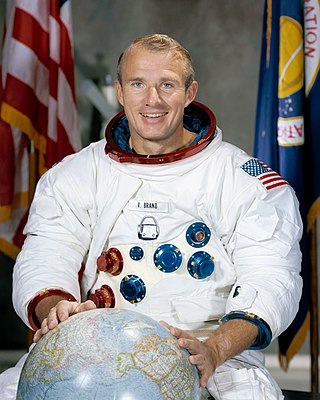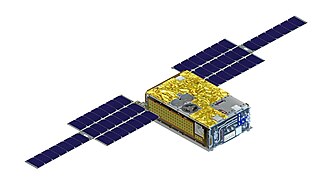
Vance DeVoe Brand is an American naval officer, aviator, aeronautical engineer, test pilot, and NASA astronaut. He served as command module pilot during the first U.S.-Soviet joint spaceflight in 1975, and as commander of three Space Shuttle missions.

The Japan Aerospace Exploration Agency (JAXA) is the Japanese national air and space agency. Through the merger of three previously independent organizations, JAXA was formed on 1 October 2003. JAXA is responsible for research, technology development and launch of satellites into orbit, and is involved in many more advanced missions such as asteroid exploration and possible human exploration of the Moon. Its motto is One JAXA and its corporate slogan is Explore to Realize.

The Canberra Deep Space Communication Complex (CDSCC) is a satellite communication station, part of the Deep Space Network of NASA's Jet Propulsion Laboratory (JPL), located at Tidbinbilla in the Australian Capital Territory. Opened in 1965, the complex was used for tracking the Apollo Lunar Module, and along with its two sister stations at Goldstone, California and Madrid, Spain is now used for tracking and communicating with NASA's spacecraft, particularly interplanetary missions. Its DSS-43 antenna is the only antenna on Earth that can send commands to Voyager 2. It is managed in Australia by the Commonwealth Scientific and Industrial Research Organisation (CSIRO) for NASA’s Space Communications and Navigation program (SCaN) at NASA Headquarters in Washington, D.C.
Collins Aerospace is an American technology company that is one of the world's largest suppliers of aerospace and defense products. Headquartered in Charlotte, North Carolina, it is a subsidiary of RTX Corporation.
The Aerospace Corporation is an American nonprofit corporation that operates a federally funded research and development center (FFRDC) in El Segundo, California. The corporation provides technical guidance and advice on all aspects of space missions to military, civil, and commercial customers. As the FFRDC for national-security space, Aerospace works closely with organizations such as the United States Space Force (USSF) and the National Reconnaissance Office (NRO) to provide "objective technical analyses and assessments for space programs that serve the national interest". Although the USSF and NRO are the primary customers, Aerospace also performs work for civil agencies such as NASA and NOAA as well as international organizations and governments in the national interest.

The Chinese Lunar Exploration Program, also known as the Chang'e Project after the Chinese Moon goddess Chang'e, is an ongoing series of robotic Moon missions by the China National Space Administration (CNSA). The program encompasses lunar orbiters, landers, rovers and sample return spacecraft, launched using the Long March series of rockets. A human lunar landing component may have been added to the program, after China publicly announced crewed lunar landing plans by the year 2030 during a conference in July 2023.

Spaceflight began in the 20th century following theoretical and practical breakthroughs by Konstantin Tsiolkovsky, Robert H. Goddard, and Hermann Oberth, each of whom published works proposing rockets as the means for spaceflight. The first successful large-scale rocket programs were initiated in Nazi Germany by Wernher von Braun. The Soviet Union took the lead in the post-war Space Race, launching the first satellite, the first animal, the first human and the first woman into orbit. The United States would then land the first men on the Moon in 1969. Through the late 20th century, France, the United Kingdom, Japan, and China were also working on projects to reach space.
Honeybee Robotics, LLC is a subsidiary of Blue Origin that builds advanced spacecraft, robotic rovers, and other technologies for the exploration of Mars and other planetary bodies in deep space. The company, headquartered in Brooklyn, New York, has additional production facilities in Altadena, California and Longmont, Colorado. The company has 284 employees and creates exploration systems, infrastructure systems, and motion control software for the National Aeronautics and Space Administration (NASA), the Japanese Aerospace Exploration Agency (JAXA), Blue Origin, and other customers. On May 19th, 2023, Honeybee Robotics' parent company, Blue Origin, won a $3.4 Billion contract to build a moon lander and additional spacecraft for NASA's Artemis program. The team, led by Blue Origin, is a partnership between Lockheed Martin, Draper, Boeing, Astrobotic, and Honeybee Robotics.

Rocket Lab USA, Inc. is a publicly traded aerospace manufacturer and launch service provider that operates and launches lightweight Electron orbital rockets used to provide dedicated launch services for small satellites as well as a suborbital variant of Electron called HASTE. The company plans to build a larger Neutron rocket as early as 2025. Electron rockets have launched to orbit 46 times from either Rocket Lab's Launch Complex 1 in New Zealand or at the Mid-Atlantic Regional Spaceport in Wallops Island, Virginia, United States. Rocket Lab has launched one sub-orbital HASTE rocket to date from Wallops Island, Virginia. In addition to the Electron, Neutron, and HASTE launch vehicles, Rocket Lab manufactures and operates spacecraft and is a supplier of satellite components including star trackers, reaction wheels, solar cells and arrays, satellite radios, separation systems, as well as flight and ground software.

A space tug is a type of spacecraft used to transfer spaceborne cargo from one orbit to another orbit with different energy characteristics. The term can include expendable upper stages or spacecraft that are not necessarily a part of their launch vehicle. However, it can also refer to a spacecraft that transports payload already in space to another location in outer space, such as in the Space Transportation System concept. An example would be moving a spacecraft from a low Earth orbit (LEO) to a higher-energy orbit like a geostationary transfer orbit, a lunar transfer, or an escape trajectory.
The (Japanese) Lunar Exploration Program is a program of robotic and human missions to the Moon undertaken by the Japanese Aerospace Exploration Agency (JAXA) and its division, the Institute of Space and Astronautical Science (ISAS). It is also one of the three major enterprises of the JAXA Space Exploration Center (JSPEC). The main goal of the program is "to elucidate the origin and evolution of the Moon and utilize the Moon in the future".

Firefly Aerospace is an American private aerospace firm based in Cedar Park, Texas, that develops launch vehicles for commercial launches to orbit. The company completed its $75 million Series A investment round in May 2021, which was led by DADA Holdings. The current company was formed when the assets of the former company Firefly Space Systems were acquired by EOS Launcher in March 2017, which was then renamed Firefly Aerospace. Firefly's stated purpose is to increase access to space, similar to other private spaceflight companies.

The Near-Earth Asteroid Scout was a mission by NASA to develop a controllable low-cost CubeSat solar sail spacecraft capable of encountering near-Earth asteroids (NEA). NEA Scout was one of ten CubeSats launched into a heliocentric orbit on Artemis 1, the maiden flight of the Space Launch System, on 16 November 2022.

ArgoMoon is a CubeSat that was launched into a heliocentric orbit on Artemis 1, the maiden flight of the Space Launch System, on 16 November 2022 at 06:47:44 UTC. The objective of the ArgoMoon spacecraft is to take detailed images of the Interim Cryogenic Propulsion Stage following Orion separation, an operation that will demonstrate the ability of a cubesat to conduct precise proximity maneuvers in deep space. ASI has not confirmed nor denied whether this took place, but several images of the Earth and the Moon were taken.

The Roll Out Solar Array (ROSA) and its larger version ISS Roll Out Solar Array (iROSA) are lightweight, flexible power sources for spacecraft designed and developed by Redwire.

EQUULEUS is a nanosatellite of the 6U CubeSat format that will measure the distribution of plasma that surrounds the Earth (plasmasphere) to help scientists understand the radiation environment in that region. It will also demonstrate low-thrust trajectory control techniques, such as multiple lunar flybys, within the Earth-Moon region using water steam as propellant. The spacecraft was designed and developed jointly by the Japan Aerospace Exploration Agency (JAXA) and the University of Tokyo.

OMOTENASHI was a small spacecraft and semi-hard lander of the 6U CubeSat format intended to demonstrate low-cost technology to land and explore the lunar surface. The CubeSat was to take measurements of the radiation environment near the Moon as well as on the lunar surface. Omotenashi is a Japanese word for "welcome" or "Hospitality".

Intuitive Machines, Inc. is an American space exploration company headquartered in Houston, Texas. It was founded in 2013 by Stephen Altemus, Kam Ghaffarian, and Tim Crain, to provide lunar surface access, lunar orbit delivery, and communication from lunar distance. Intuitive Machines holds three NASA contracts under the space agency's Commercial Lunar Payload Services (CLPS) initiative, to deliver payloads to the lunar surface.Among these, the company holds a contract to develop a Lunar Terrain Vehicle (LTV).
Deep Space Systems, Inc (DSS) is a private aerospace company dedicated to systems engineering that supports the design, development, integration, testing and operations of science and exploration spacecraft.

CAPSTONE is a lunar orbiter that is testing and verifying the calculated orbital stability planned for the Lunar Gateway space station. The spacecraft is a 12-unit CubeSat that is also testing a navigation system that is measuring its position relative to NASA's Lunar Reconnaissance Orbiter (LRO) without relying on ground stations. It was launched on 28 June 2022, arrived in lunar orbit on 14 November 2022, and was scheduled to orbit for six months. On 18 May 2023, it completed its primary mission to orbit in the near-rectilinear halo orbit for six months, but will stay on this orbit, continuing to perform experiments during an enhanced mission phase.

















